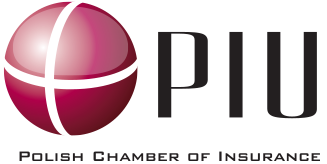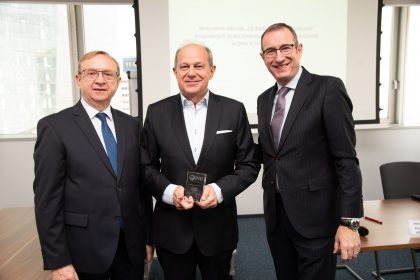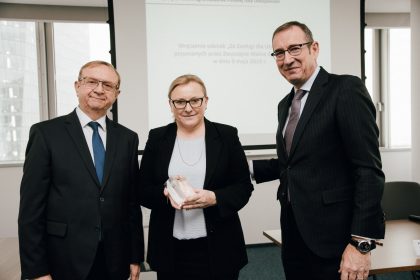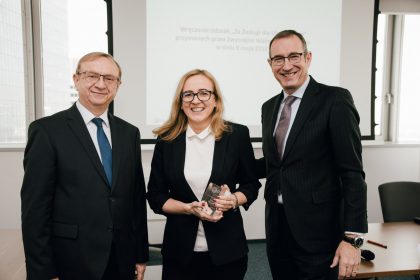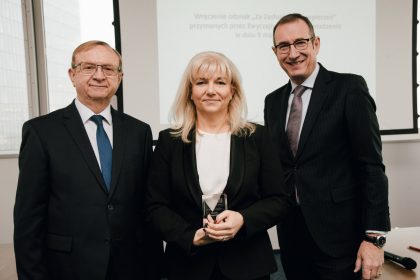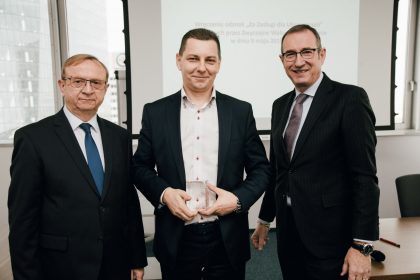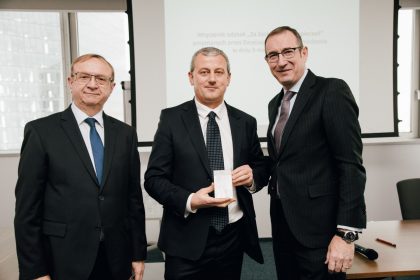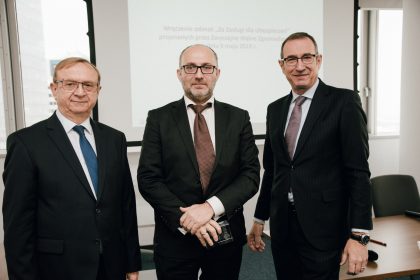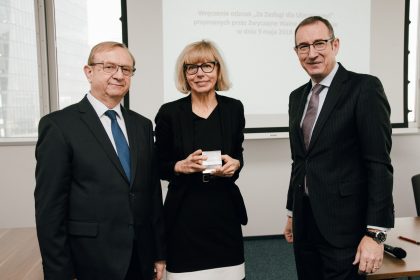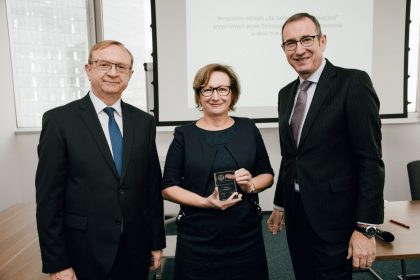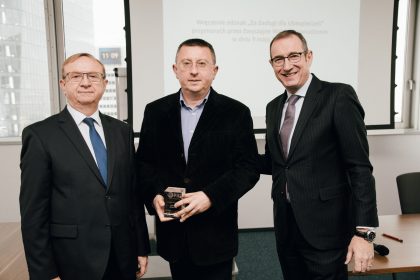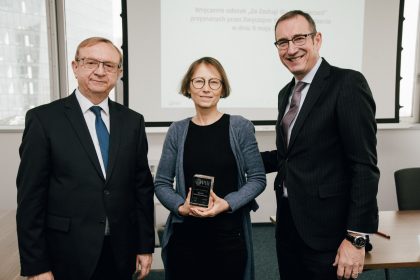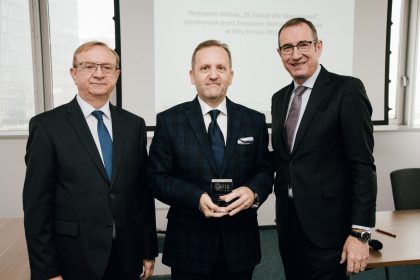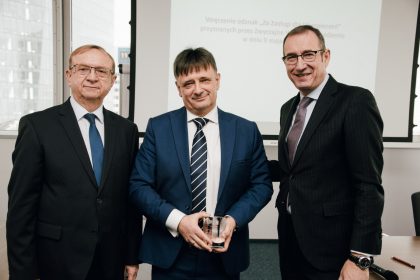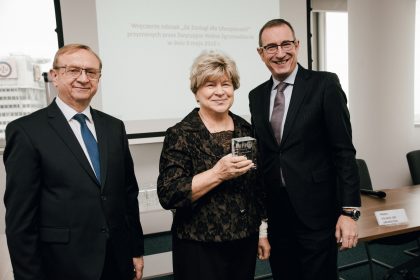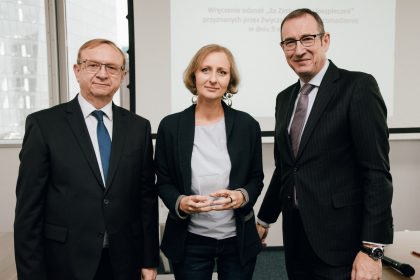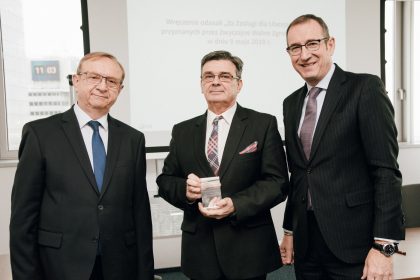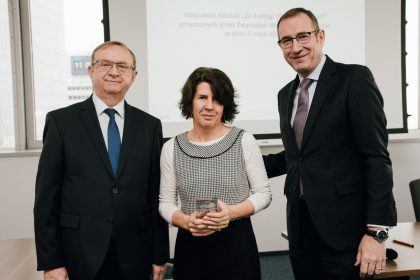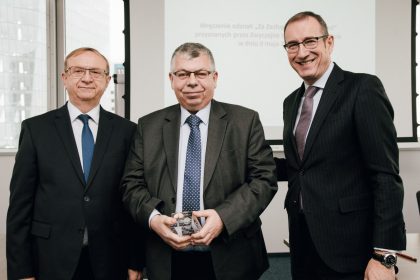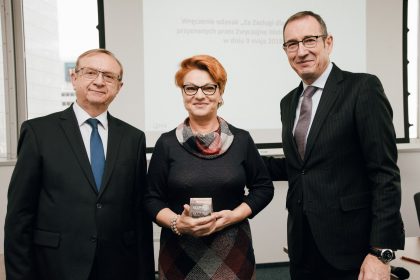In 2018, insurers paid out nearly PLN 42 billion to the injured and customers. This is 4.7% more than last year. Almost 14 billion in damages was for the injured covered
by motor insurance.
Key figures for the insurance market in 2018 (download the infographic)
- Every thirty seconds, the injured covered by RCA receive payment from the insurer
- Nearly PLN 17 billion of insurers’ assets are funds invested on a long-term basis in the shares of companies from the WSE and other variable-income securities
- Insurers paid PLN 1.3 billion income tax to the State budget
- The market has more than PLN 40 billion in provisions for future aid for injured persons
Motor insurance market
- Gross compensations and benefits under RCA amounted to PLN 9 billion (an increase of 4.6%)
- Gross compensations and benefits under AC insurance amounted to PLN 5 billion (an increase of 9.9%)
‘Payments from motor insurance are higher than in the previous year. In addition, the last quarter of 2018 showed that they are increasing ever more dynamically. At the same time, the growth of premiums in obligatory RCA is decelerating. The profitability of the RCA market does not exceed 3%,
while huge pressure from repair workshops and compensation claims companies to increase the payments is making the market unpredictable. It could be helpful, for example, to regulate compensation, i.e. benefits for pain and suffering’, said J. Grzegorz Prądzyński, president of the Board of the Polish Chamber of Insurance.
Non-life market (Chapter 2 excluding motor insurance)
- PLN 1.3 billion in damages to people injured by fire and other natural forces
- PLN 1.2 billion was received by the injured due to various types of theft, as well as hail and frost, mainly agricultural damage
- More than PLN 600 million was received by people injured in accidents and due to illnesses
‘We need to be prepared for the increasingly frequent occurrence of violent weather events. Insurers are financially prepared to provide coverage; unfortunately, without a good disaster risk management policy, we need to be ready for growing damage resulting from this fact. It was one of the reasons we decided to prepare a report entitled: “Climate of risk. How can prevention and insurance reduce the impact of natural disasters on the environment?”’, explained Andrzej Maciążek, vice-president of the Board of PIU.
Life insurance market
- The value of benefits from life insurance amounted to PLN 21.5 billion (a 5.6% increase)
- More than PLN 2.5 billion in benefits were received by people injured in accidents
‘The life insurance market may change in the near future through Employee Capital Plans. Some insurers will choose to offer them and some will intermediate in offering them. I have no doubt that thanks to ECP and the work of insurers, many people will be able to accumulate additional retirement savings’, said J. Grzegorz Prądzyński.
Insurers’ financial results
- The net profit of life insurers in 2018 amounted to PLN 2.4 billion and was 7.6% higher than the previous year
- Non-life insurers ended the year 2018 with a profit of PLN 4.1 billion, which means an increase of 18.5% (approx. one third of this result was made up of a dividend from PZU Życie SA to PZU SA, already included in the last year’s life insurers’ net profits)
The technical result on life insurance amounted to PLN 3.1 billion and was 1.3% higher than the previous year. The technical result of non-life insurers amounted to PLN 2.9 billion and was nearly 43% higher than the previous year. Such a significant improvement of results was, among other things, influenced by better risk management in motor insurance and a lower number of incidents resulting in payments for insurance against fire and other natural forces. It is worth adding that both the improvement and the decrease in the technical result in property insurance is cyclical and often depends on one-off events, especially in the case of major damage caused by natural forces.
The income tax payable by Polish insurers for 2018 amounted to PLN 1.3 billion, and the tax on assets was approx. PLN 720 million.
On 1 March 2019, the Polish Chamber of Insurance opened its representative office in Brussels. Its aim is to take an active role in legislative work in the European forum and represent the interests of the Polish insurance market. The PIU office will also provide expert advice on the implementation of EU legislation into national law. PIU was joined by Iwona Szczęsna, whose task is to organise the work of the PIU office in Brussels. Her previous professional experience includes, among others, the co-establishment of EIOPA and management of the International Cooperation Division in the field of the insurance and pension fund market at the Polish Financial Supervision Authorit‘. ‘PIU has been strengthened by a person with extensive experience in the field of international cooperation. This is very important in times when increasingly more legal regulations originate outside Poland. In order to perform our statutory duties as best as possible, we must constantly monitor the work of the most important European institutions’, said Jan Grzegorz Prądzyński, president of the Board of PIU. ‘I am pleased that the domestic insurance market will have its permanent representative in Brussels. It is a great honour for me and an opportunity to support a statutorily authorised organisation in looking after the interests of the Polish market’, said Iwona Szczęsna.
We invite you to the VII Congress of the Polish Insurance Association “Europe – innovations, inspirations, regulations”, that will take place on May 8-9, 2019 in Sheraton Sopot hotel. Registration panel is available at http://kongres-piu.pl/en
Insurance companies involved in the insurance of receivables collect a vast amount of information for insurance risk assessment. Different terminology and question templates used by brokers and companies, result in customers having to prepare data multiple times using different formats. The use of different names for the same terms also contribute to interpretative doubts, thereby hindering the risk assessment process. In view of these difficulties, companies have initiated the development of good practices in this area.
The Minimum Information Requirements for risk assessment in the insurance of receivables, hereinafter referred to as the ‘Minimum Information Requirements’, were drawn up by the Receivables Insurance Subcommittee of the Polish Chamber of Insurance and adopted by the Board of PIU by way of resolution on 18 January 2019.
These are recommendations aimed at ensuring a high standard of insurance services. The recommendations contain a set of questions to obtain the minimum amount of information necessary for a fair assessment of insurance risk. Such an assessment of insurance risk is necessary to decide whether to accept the risk for insurance and to calculate the premium. It affects the ability of the insurance company to comply with the insurance agreement. Therefore, the application of Minimum Information Requirements is not only in the interest of insurers but also of the insured and other beneficiaries of the insurance agreement.
Minimum information requirements for receivables insurance
The ‘In recognition of service to the insurance industry’ awards were presented on 7 January 2019 during the Extraordinary General Assembly of the Polish Chamber of Insurance. For many years now, PIU has been awarding people and institutions for their work for the industry’s professional association and contribution to the development of the Polish insurance market.
You are invited to read the report by the Polish Chamber of Insurance, describing the bancassurance market in Poland after Q3 2018. The premium obtained in the bancassurance channel amounted to PLN 4.5 billion in Section 1 and 1.4 billion in Section 2.
After three quarters of 2018, insurers had paid out nearly PLN 31 billion to the injured and customers. As usual, most damages and adjusted claims concerned motor insurance.
Key insurance market figures after Q3 2018
- More than PLN 70 billion of insurers’ assets are funds supporting the economy and public finances by domestic bonds and other fixed-income securities
- Nearly PLN 17 billion of insurers’ assets are funds invested on a long-term basis in the shares of companies from the WSE and other variable-income securities
- PLN 1 billion income tax to the State budget
- Insurers collected more than PLN 46 billion of premiums, 0.3% more than last year
Motor insurance market
Key figures:
- Gross compensations and benefits under RCA amounted to PLN 6.6 billion (an increase of 4.2%)
- Gross compensations and benefits under AC amounted to PLN 3.7 billion (an increase of 9.4%)
- PLN 568.7 is the average premium under the annual agreement on RCA for motor vehicle owners in Q3 2018 — 0.1% less than one year ago
- PLN 7,428 is the average loss on the agreement on RCA for motor vehicle owners at the end of Q3 2018 — less than 3% more than one year ago
‘Throughout the whole of 2018, the growth of premium in obligatory RCA for motor vehicle owners has been decelerating. At the moment, there is no ongoing work on regulations which could suddenly increase the costs of damages and benefits. This in turn reduces the likelihood of a sudden increase in prices’, said Grzegorz Prądzyński, president of the Board of the Polish Chamber of Insurance.
Non-life market (Chapter 2 excluding motor insurance)
Key figures:
- The total premiums for property insurance (exclusive of motor vehicles) amounted to PLN 12.4 billion and was 10.6% higher than the previous year.
- The following types of insurance have the largest share in the premium in the non-life insurance market: insurance against other property damage (PLN 2.4 billion, an increase of 16.7%), insurance against fire and other natural forces (PLN 2.4 billion, an increase of 2.5%) and general RCA (PLN 1.6 billion, YoY increase of 12.7%)
‘The PIU report entitled “Climate of risk. How can prevention and insurance reduce the impact of natural disasters on the environment?” shows clearly that the following years are marked by an increase in violent weather events. Unfortunately, without a good risk management policy, we also need to be ready for growing damage resulting from this fact’, explained Andrzej Maciążek, vice-president of the Board of PIU.
Life insurance market
Key figures:
- Value of the premium on life insurance amounted to PLN 16.4 billion (a decrease of 10.3%)
- The value of benefits from life insurance amounted to PLN 15.9 billion (an increase of 5.1%)
‘We are already familiar with the provisions of the act on Employee Capital Plans. The objectives of the ECP will be implemented with the participation of insurers. Some insurance companies will decide to offer ECP, while some will decide to act as intermediaries in offering plans, created within a capital group’, said J. Grzegorz Prądzyński.
Insurers’ financial results
- The net profit of life insurers after Q3 2018 amounted to PLN 2 billion and was 5.6% higher than a year ago
- Non-life insurers ended Q3 2018 with a profit of nearly PLN 3.7 billion, which means an increase
of 24.6%; however, one third of this result is made up of a dividend from PZU Życie SA to PZU SA, already included in last year’s life insurers’ net profits
The technical result on life insurance amounted to PLN 2.4 billion and was 0.5% lower than in the previous year. The technical result of non-life insurers amounted to PLN 2.4 billion and was 57% higher than in the previous year. The income tax payable by Polish insurers at the end of Q3 2018 amounted to PLN 1 billion and asset tax — approx. PLN 540 million.
Over PLN 16 billion – such would be the cost of the 2010 flood in Poland if it had taken place in 2018. The same impact of natural forces as eight years ago would result in 21% greater losses. If Poland does not implement a coherent risk management policy, greater losses caused by weather phenomena will become realistic, according to the latest report of the Polish Chamber of Insurance, ‘Climate of risk. How can prevention and insurance reduce the impact of natural disasters on the environment?’, prepared together with the consulting company of Deloitte. Honorary patronage over the report was assumed by the Ministry of the Environment.
‘Our climate is changing. Extreme weather phenomena are intensifying. At the same time, we are developing at a very rapid pace. Economic and civilisation development means that the cost of possible natural disasters will grow’, – said Jan Grzegorz Prądzyński, President of the Board of PIU. – ‘This can be avoided, and we therefore want to draw attention to the need for concrete measures which can significantly reduce the negative impact of natural disasters’ – he added.
According to the report by PIU and Deloitte, in Poland, the cities which are the most vulnerable to natural disasters and their socio-economic costs are Warsaw, Tri-City and Krakow. This is primarily the result of the largest population density and the amount of fixed assets in large cities. High positions are also occupied by Wrocław, Poznań, Łódź and Katowice. According to simulations carried out by PIU and Deloitte, a hypothetical flood in 2018, with the strength of the flood in 2010, would expose us to losses of PLN 16.2 billion, including private and public property, including investments of companies, local governments and the central budget. The largest loss would be borne by the Małopolskie and Podkarpackie Provinces.
A real threat of blackout
Climate change is also linked to increasing energy consumption. Increasingly hot and arid summers in Poland cause, among other things, greater energy demand, for example, due to the use of air conditioning. The intensity of extreme events (storms, violent winds) threatens the transmission infrastructure. This creates an increasing risk of a so-called blackout; namely an uncontrolled interruption in the supply of electricity for a large area of the country. ‘In the report, we estimate that if the weather or a massive cyber-attack caused an ongoing 8-hour-long interruption of energy supply today, the cost of the failure throughout Poland would be PLN 2.6 billion’, said Jan Grzegorz Prądzyński.
The world has ideas on risk management
In 2015, the UN Member States concluded an international agreement in Sendai, assigning government administrations the main role in disaster risk management, with the responsibility being shared by other entities, including local governments and the private sector.
‘Risk management means, among other things, investments. They reduce the likelihood of damage or its value, which is particularly apparent in the energy sector. The development of infrastructure or diversification of energy sources would have a significant positive impact on risk management in terms of energy security’, commented Irena Pichola, a partner, leader of the energy, sustainable development and economic analysis team at Deloitte.
Tasks for Poland
The growing frequency of natural disasters requires a new reorganisation of risk reduction processes. This can be achieved through appropriate education, preventive and adaptive measures, as well as transfer of risk, offered by insurers. At the same time, it should be remembered that security and stabilisation in the event of weather-related disasters can only be ensured by integrated actions of state authorities, society and the insurance sector. ‘Insurance is a part of crisis management, but it cannot replace it. The most important aspect is prevention, data collection and analysis’, commented Jan Grzegorz Prądzyński.
Report: ‘Climate of risk. How can prevention and insurance reduce the impact of natural disasters on the environment?’
Key figures from the report
More than 2.4 million people have additional health insurance. The number of people insured increased by 20% over the year, according to data from the Polish Chamber of Insurance (PIU). This figure is likely to continue to grow and the coverage of policies will increase.
Employers want healthier workers
During the first three quarters, we spent PLN 586 million on additional health insurance. This is almost 19% more than one year ago. ‘According to data, the level of group insurance premium is growing slightly faster than the number of insured persons. This clearly shows that employers want to provide their employees with more access to medical benefits, and consequently the popularity of broader packages is increasing. This is due medical issues on one hand and the competition for workers on the other’, explained Dorota M. Fal, advisor to the Board of the Polish Chamber of Insurance. ‘Employers also seek to reduce the health-related absenteeism of their employees, which represents a real cost for companies. The Social Insurance Institution announced that in 2017, entrepreneurs spent PLN 6.3 billion of their own money to finance the first month of sick leave of their employees’, she added.
Almost two years of waiting
According to recent Public Opinion Research Centre data, 60% of Polish people have a negative opinion about the functioning of the National Health Fund. Well-educated people criticise it the most. According to a report prepared by the Watch Health Care Foundation, Warsaw Enterprise Institute and MAHTA, Poles have to wait on average for about 3 months to see a specialist and nearly 4 months to receive a single guaranteed benefit. This is 2 weeks longer than last year. The worst situation is for access to an endocrinologist, where the average waiting time is up to 23 months.
Adam Malinowski, member of the Management Board of Generali was appointed chairman of the Property Insurance Subcommittee of the Polish Insurance Association. Among other issues, the new chairman starts work for the Subcommittee on the implementation of the new act on insurance distribution. Adam Malinowski said
I consider as a huge responsibility the confidence placed in me by the Polish Insurance Association by entrusting me with the chairmanship of the Subcommittee. The sale of insurance is a complex discipline, which combines product, billing, legislative, procedural and IT elements. I am glad that key individuals in the Polish insurance market have agreed to become members of the Subcommittee. As a result, we will surely be able to develop solutions to major challenges in insurance distribution, such as the implementation of statutory requirements and preparation of good practices in this regard. I believe that this cooperation will also become a perfect platform for exchanging best experiences and that the committee’s work will also contribute to bringing insurance closer to Polish people and increasing their insurance awareness.
The Subcommittee includes Łukasz Heinowski, Head of the Multi-agency Sales Office of PZU, Grzegorz Kulik, Vice-President of the Management Board of Allianz, Adam Łoziak, Vice-President of the Management Board of UNIQA, Małgorzata Makulska, Vice-President of the Management Board of ERGO Hestia, Artur Maliszewski, President of the Management Board of Axa, Jarosław Piątkowski, Vice-President of the Management Board of Warta, Jarosław Szwajgier, Vice-President of the Management Board of Compensa and Agnieszka Wrońska, President of the Management Board of LINK4. Barbara Sanek, legal counsel at the Polish Insurance Association, was appointed secretary of the Subcommittee.
